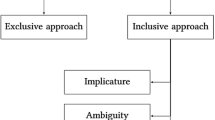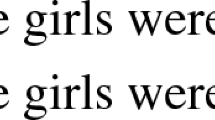Abstract
The paper offers an account of languages such as Hungarian which donot allow for number concord, that is, for several noun-phrase internal realisationsof plural. It is looked at the combinations of noun and adjective, numeraland noun, and subject and verb. I first show that an underspecification analysisfails to capture the data. I argue that nevertheless, the lack of number agreementin this language type is only apparent and that it is still possible to stickto the concept of feature unification for these constructions. The solutionI propose is coached in the framework of Optimality Theory and crucially relieson an economy constraint which I call PEPL and which outranks two other constraints:MAP, which requires a correspondence of semantic aggregate individuation andthe morphological feature [+pl]; and REALISE (μ), which requires that affixmaterial that fits into the morphosyntactic context should be realised. Aconsequence of the analysis is that non-default mapping of aggregate semanticsto the morphosyntactic specification [+pl] is a typological option in orderto respect formal agreement. The variation between “Type Hungarian”languages and “Type English” languages (i.e., languages that exhibitplural concord) is thus accounted for in terms of a different ranking of theconstraints that require morphological economy (PEPL) and explicitness (MAP,REALISE (μ), respectively.
Similar content being viewed by others
References
Akrawy, F.R. 1982. Standard Kurdish grammar. Published by the author.
Amin-Madani, S.-Lutz, D. 1972. Persische Grammatik. Groos, Heidelberg.
Aronson, H.I. 1991. Modern Georgian. In: Harris, A.C. (ed.): The indigenous languages of the Caucasus, Vol. 1: the South Caucasian languages, 219–312. Caravan, Delmar N.Y.
Barnas, U.B.-Salzer, J. 1994. Lehrbuch der kurdischen Sprache. Wien.
Carstens, V. 1991. The morphology and syntax of Determiner phrases in Kiswahili. Ph.D. Dissertation, UCLA, Los Angeles.
Cerron-Palomino, R. 1976. Grammática quechua: Junin-Huanca. Ministerio de Educación/ Instiuto de Estudios Peruanos, Lima.
Colarusso, J. 1989. East Circassian (Kabardian dialect). In: Hewitt, G.B. (ed.): The indigenous languages of the Caucasus, Vol. 2: the North West Caucasian languages, 261–355. Caravan, Delmar N.Y.
Fabri, R. 1993. Kongruenz und die Grammatik des Maltesischen (Linguistische Ar-beiten 292). Niemeyer, Tübingen.
Grimshaw, J. 1997. Projection, heads, and optimality. In: Linguistic Inquiry 28: 373–422.
Grimshaw, J. 1998. Optimization and variation in the functional lexicon. Paper presented at “Lexicon in focus: International Conference of the SFB 282 ‘Theory of the Lexicon’”, Wuppertal, August 17-19, 1998.
Harris, A.C. 1981. Georgian syntax. A study in Relational Grammar. (Cambridge studies in linguistics 33). Cambridge University Press, Cambridge.
Harris, A.C. 1985. Diachronic syntax: the Kartvelian case. (Syntax and semantics 18). Academic Press, Orlando FL.
Hewitt, G.B. 1989. Abkhaz. In: Hewitt, G.B. (ed.): The indigenous languages of the Caucasus, Vol. 2: the North West Caucasian languages, 37–88. Caravan, Delmar N.Y.
Holisky, D.A.-Rusudan, G. 1994. Tsova-Tush (Bastbi). In: Smeets, R. (ed.): The indigenous languages of the Caucasus, Vol. 4: North East Caucasian languages, Part 2. The three Nakh languages and six minor Lezgian languages, 147–212. Caravan, Delmar N.Y.
Jespersen, O. 1924/1968. The philosophy of grammar. Allen and Unwin, London.
Kenesei, I.-Vago, R.M.-Fenyvesi, A. 1998. Hungarian. Routledge, London.
Kibrik, A.E. 1994. Archi. In: Smeets, R. (ed.): The indigenous languages of the Caucasus, Vol. 4: North East Caucasian languages, Part 2. The three Nakh languages and six minor Lezgian languages, 297–367. Caravan, Delmar N.Y.
Lewis, G.L. 1967. Turkish grammar. Clarendon, Oxford.
Link, G. 1989. The logical analysis of plural and mass terms: a lattcie-theoretical approach. In: Bäuerle R.-Schwarze, C.-von Stechow, A. (eds): Meaning, use, and interpretation of language, 302–23. de Gruyter, Berlin.
McCarthy, J.-Prince, A. 1995. Faithfulness and reduplicative identity. In: Beckmann, J.-Urbanczyk, S.-Walsh, L. (eds): Papers in Optimality theory. University of Massachusetts occasional papers in linguistics 18, 249–384. GSLA, Amherst.
Mithun, M. 1988. Lexical categories and the evolution of number marking. In: Hammon, M.-Noonan, M. (eds): Theoretical morphology. Approaches to modern linguistics, 211–34. Academic Press, San Diego.
Ojeda, A. 1993. Linguistic individuals. CSLI Lecture Notes no. 3. Stanford, CSLI.
Ortmann, A. 1992. Zur Auflösung von Merkmalskonflikten unter Kongruenz. Arbeiten des Sonder-forschungsbereichs 282-Theorie des Lexikons-No. 24. Heinrich-Heine Universität, Düsseldorf.
Ortmann, A. 2000. Morphologische Kategorien des Nomens: Merkmale, lexikalischer Struk-turaufbau und Ökonomie. Doctoral dissertation, Heinrich-Heine-Universität, Düsseldorf.
Pollard, C.-Sag, I.A. 1994. Head-driven Phrase Structure Grammar. The University of Chicago Press, Chicago and London.
Prince, A.-Smolensky, P. 1993. Optimality Theory: constraint interaction in generative grammar. Ms., Rutgers University and University of Colorado. (To appear, Cambridge MA, MIT Press).
Szabolcsi, A. 1994. The Noun Phrase. In: Kiefer, F.-É. Kiss, K. (eds): The syntactic sucture of Hungarian. (Syntax and semantics 27), 179–274. Academic Press, New York.
Wunderlich, D. 1994. Towards a lexicon-based theory of agreement. In: Theoretical Linguistics 20: 1–35.
Wunderlich, D. 1996. Lexical categories. In: Theoretical Linguistics 22: 1–48.
Wunderlich, D.-Fabri, R. 1996. Minimalist Morphology: An approach to inflection. In: Zeitschrift für Sprachwissenschaft 14: 236–94.
Zimmermann, I. 1998. Das dativische pronominale Klitikum in der DP-Struktur des Bul-garischen. In: Fabri, R.-Ortmann, A.-Parodi, T. (eds): Models of inflection. (Lin-guistische Arbeiten 388), 119–33. Niemeyer, Tübingen.
Author information
Authors and Affiliations
Rights and permissions
About this article
Cite this article
Ortmann, A. Where plural refuses to agree: feature unification and morphological economy. Acta Linguistica Hungarica 47, 249–288 (2000). https://doi.org/10.1023/A:1014070716711
Issue Date:
DOI: https://doi.org/10.1023/A:1014070716711




